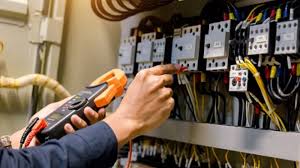
ITI in Electronics (2 Years)
ITI Electronics –Syllabus (2 Years)
Year 1
A. Trade Theory & Basic Knowledge
- Introduction to Trade & Safety
- Trade introduction & importance of Electronics Mechanic
- Occupational safety and health (OSH)
- Personal Protective Equipment (PPE)
- First aid, firefighting, emergencies at workplace
- Safety signs and symbols
- Basic Electrical / Electronics Fundamentals
- Concepts: current, voltage, resistance, power
- Ohm’s law; conductors, insulators, semiconductors
- Direct current (DC) and Alternating current (AC) fundamentals
- Magnetism, magnetic fields, electromagnetic induction
- Electrical Materials, Wires & Cables
- Types of wires, cables; insulation; voltage ratings
- Current ratings, splicing, safety in cabling
- Passive Components & Circuit Elements
- Resistors, capacitors, inductors: their types, characteristics
- Series and parallel combinations
- Reactance, impedance, resonance
- Transformers & Basic AC Circuits
- Types of transformers, construction, operation
- Single phase / three phase transformers
- AC circuits: phase relationships, power, etc.
- Measuring Instruments & Meters
- Voltmeters, ammeters, multimeters
- Wattmeter, energy meter, frequency meter, etc.
- Use of CRO (Cathode Ray Oscilloscope), function generator
- Introduction to Semiconductor Devices
- Diode, transistor (BJT), their characteristics
- Basic rectifier circuits, filters
- Basic Digital Electronics Intro
- Number systems: binary, octal, hexadecimal
- Logic gates (AND, OR, NOT, etc.), truth tables
- Computer Fundamentals & MS Office (if included)
- Basic parts of computer hardware and operating system
- Introduction to MS Word, Excel, PowerPoint (if applicable)
B. Trade Practical / Skills – Year 1
- Safety practices in workshop, tool use, handling instruments
- Use of hand tools, measuring tools, cable works
- Wiring, splicing of cables, soldering and desoldering basic components
- Assembling simple passive circuits (resistor / capacitor networks)
- Building rectifier circuits; testing transformer outputs
- Using CRO / function generator to observe waveforms
- Performing basic digital logic operations with gates
Year 2
A. Advanced Trade Theory & Specialized Topics
- Advanced Digital Electronics
- Combinational logic circuits (adder, multiplexer, decoder etc.)
- Sequential circuits: flip‑flops, counters, registers
- Operational Amplifiers & Timer ICs
- Op‑amp fundamentals, configurations
- Timer IC‑555; use in oscillator, timer circuits
- Surface Mount Technology (SMT) & SMD Components
- Identification of SMD components (2‑,3‑,4‑terminal types)
- Advantages of SMT, reflow soldering, stencil printing etc.
- Printed Circuit Boards (PCBs) & Fabrication Techniques
- Single layer, double layer, multi‑layer PCB construction
- PCB drilling, etching, layout; component mounting; track & pad design
- Power Electronics & Protection Devices
- Power electronic devices (diodes, thyristors, MOSFETs, IGBTs)
- UPS types; inverters; converters
- Protective devices: fuse, MCB, ELCB, etc.
- Communication & Consumer Electronics Topics
- Basics of communication systems, modulation, propagation
- LED / LCD / LED TV operation; interfaces, remote control basics
- Cell phones: basics of mobile communication
- Renewable Energy Systems / Solar Basics (if included)
- PV cell operation, solar panels, solar power basics
- Specialty / Emerging Topics
- Fiber optics: basics, advantages, splicing etc.
- Display devices: types, characteristics
- Analog & Digital IC applications
B. Practical / Workshop Skills – Year 2
- Soldering / reflow soldering; SMD soldering & desoldering
- PCB layout, rework, repair of PCBs
- Building and testing analog circuits: op‑amp, filters, amplifiers
- Digital circuits: designing & testing logic, sequential circuits etc.
- Using measuring instruments (DSO, CRO) for diagnosis
- Trouble‑shooting consumer electronic appliances
- Implementing small projects (e.g. LED stack driver, simple solar based circuit, etc.)

